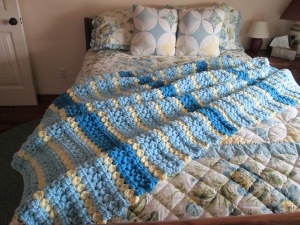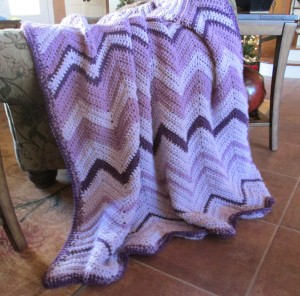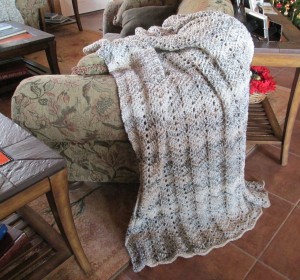Tags
Okay, so…. it’s French Country. Un nom Francais seemed appropriate. Granny stitches are very popular, but I don’t like granny squares. I do like the texture of the granny cluster stitch. I thought it might be nice to emphasize it with nothing but row upon row of extra-large granny stitches. I picked the blue and yellow scheme for the “blue” room we keep ready for our #1 daughter. This is La Mamie en Bleu (or the Granny in Blue).
 The stitch is 4 dctog, YO, and pulling up each stitch about an inch high to form very large clusters. It is very important to keep the tension steady so the clusters or loops do not sag. I found the best way was to pause at a certain point in the rhythm. YO, insert hook, YO, pull through, pause and feed yarn with opposite hand, pull up to height of last stitch, repeating till ready to finish cluster.
The stitch is 4 dctog, YO, and pulling up each stitch about an inch high to form very large clusters. It is very important to keep the tension steady so the clusters or loops do not sag. I found the best way was to pause at a certain point in the rhythm. YO, insert hook, YO, pull through, pause and feed yarn with opposite hand, pull up to height of last stitch, repeating till ready to finish cluster.
I used Red Heart Super Saver Worsted 4 Light Blue (LB), Delft Blue (DB), with Pale Yellow (Y) for the accent. Finished size is approx. 48″ x 66″. See Pattern La Mamie en Bleu.
There is no border on this one, as the fluffy clusters offset each other on every row, which gives a picot effect down each side. I love how this turned out. Hope you do, too.








